-
Car Reviews
- All reviews
- Midsize SUVs
- Small cars
- Utes
- Small SUVs
- Large SUVs
- Large cars
- Sports SUVs
- Sports cars
- Vans
Latest reviews
- Car News
-
Car Comparisons
Latest comparisons
- Chasing Deals
Though it might be a staple in the small SUV world, the Venue isn’t the freshest compact on the block. So is it still a good, cost-effective runabout option?
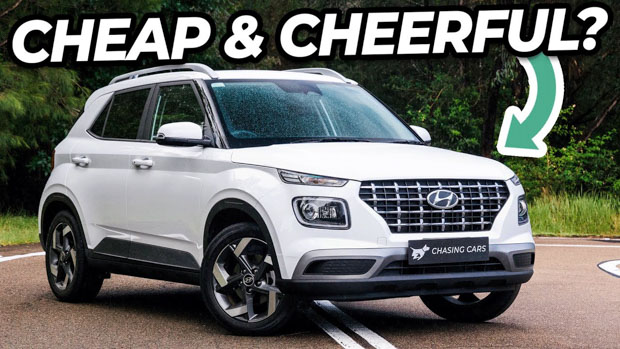
As the second-most popular new vehicle segment behind midsize SUVs, it’s little surprise to see manufacturers scrambling to bring new small SUV offerings to the market.
Hyundai is one brand that adopted the small SUV relatively early, first introducing the Kona in 2018, and closely following it with the (categorically compact) Venue in 2019.

But at almost four years old, it’s fair to say that this Venue is probably due an update, and Hyundai is aware of this.
The Korean brand actually introduced a facelifted Venue to the Indian market last year, which updated the exterior styling as well as adding a few interior features.
Though Hyundai Australia has yet to mention any news regarding the facelifted Venue, the first-generation model recently gained a few upgrades, making it a more appealing offering.
These updates included a digital cluster, a wireless phone charging pad, and a new rear occupant alert.
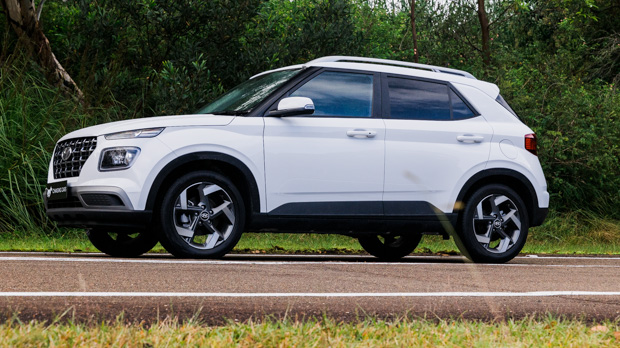
The Elite is Hyundai’s range-topping variant of the Venue range, and is priced accordingly at $32,175 on the road. That’s around $7000 more than the entry-level Venue – hardly chump change at this price point – and against some of its rivals the high-spec Korean does start to lose its cost-effectiveness.
In terms of rivals, the small SUV is extremely competitive, but buyers will most likely be cross-shopping the Venue against other compact SUVs such as the Kia Stonic and the Mazda CX-3.
At $30,790 before on-road costs, the Stonic GT-line proves to be a particularly tough rival with its turbo-petrol 1.0-litre engine that pumps out 74kW/133Nm.
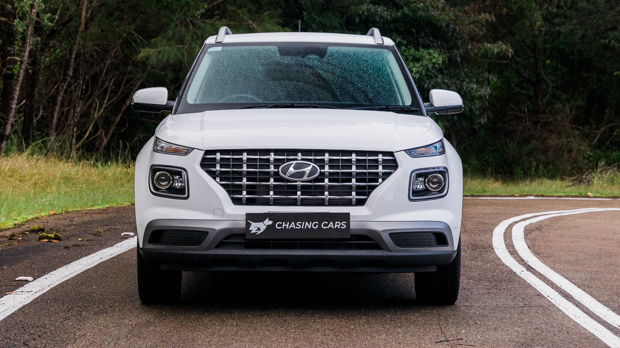
The Chery Omoda 5 is also worth a mention considering it falls into the Venue Elite’s price category at $29,900, but it’s worth noting that it’s technically one size up in the SUV world.
Though these brands don’t carry the lineage that Hyundai does in Australia, both feature an impressive amount of kit over the Venue Elite, making the dealer all the more sweeter.
So is the Hyundai Venue still a cost-effective choice in the age of the cut-price Chinese small SUV? Or are buyers better off going with the new kids on the block?
In Australia, Hyundai’s Venue range starts at $25,190 (driveaway) for the entry-level model.
Beneath the bonnet sits a 1.6-litre naturally aspirated four-cylinder petrol engine that makes 90kW and 151Nm.
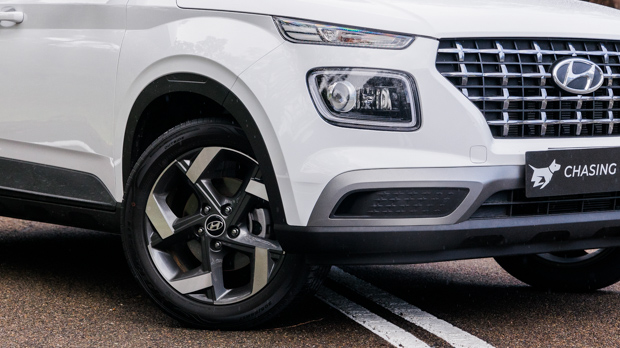
As standard, this engine is paired with either a six-speed manual transmission that sends power exclusively to the front wheels. Buyers can opt for a six-speed automatic transmission at a $2000 premium.
It’s worth noting that this engine is standard across the entire Venue range in Australia, and the manual transmission is only an option on the base model.
On the outside, standard kit is reasonably basic with the entry-level Venue, with 15-inch alloy wheels and roof rails included.
In terms of paint, Atlas White is included, but those looking for any other shade will have to fork out an extra $595.
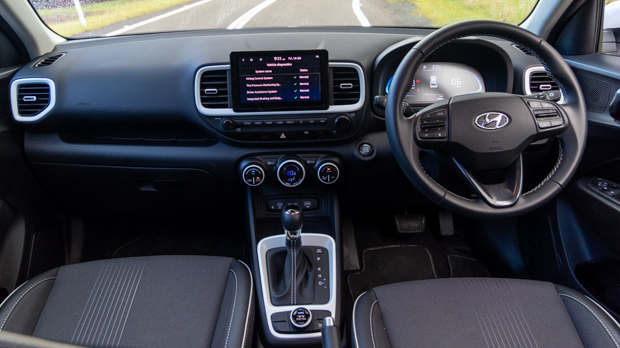
On the inside, the basic theme continues with manual, cloth seats, and hard touch plastics covering the majority of surfaces. It also makes do with a basic air conditioning system with manual controls.
An 8.0-inch infotainment screen sits in the centre of the dash and gets wireless Apple Carplay and Android Auto connectivity. There’s also a wireless phone charging pad and a 4.2-inch digital cluster included.
On the safety front, the inclusions are slim with an old-fashioned cruise control system, lane-keep assist and a rear-view camera. This base grade Venue also misses out blind-spot warning system and reverse parking warning system.
Making the $4410 jump up in the range will get buyers into the Venue Active at $29,600 driveaway, though given the mid-ranger is automatic only the effective walk-up is $2410 auto to auto.
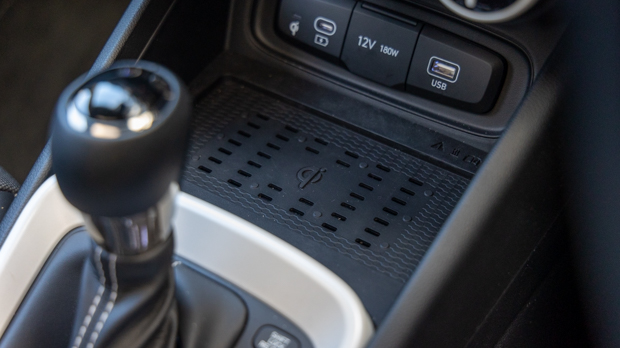
On the outside, the Active is almost identical to the base grade, but it gets a set of 17-inch alloys in place of the 15s.
Standard kit on the inside is very similar again, with the main change being the addition of a six-speaker audio system in place of the four-speaker system.
On the safety front, reversing sensors and a guidance display is added to the camera system.
At the top of Hyundai’s local Venue range is the Elite, which starts from $32,175 on the road.
Visually, the Elite is almost identical to the Active on the outside, with the same 17-inch alloy wheels, but the addition of a chrome grille, body coloured accents set the range-topper apart.
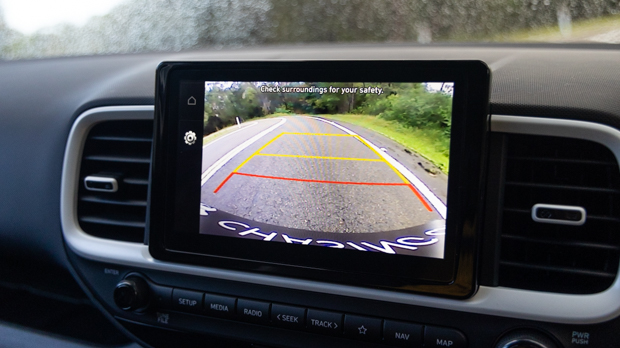
Paint options remain the same for the Elite, but buyers can opt for a black roof for no extra cost.
The biggest change on the inside of the Venue Elite is the addition of satellite navigation to the 8.0-inch infotainment screen.
It’s worth noting that this comes at the cost of wireless phone projection, meaning drivers will have to plug their phone in to get Apple Carplay and Android Auto to work.
Safety systems are also slightly improved in the Elite, with blind spot monitoring added.
With a naturally aspirated engine beneath the bonnet, the Venue is somewhat of an anomaly in an age where turbocharged engines are the standard. Not only does forced induction improve power output, but is a far more efficient use of energy.
On the road, the Venue lacks the refinement of some of the more modern turbocharged small SUVs it competes with such as the aforementioned Kia Stonic GT-Line with its boosted 1.0-litre mill.
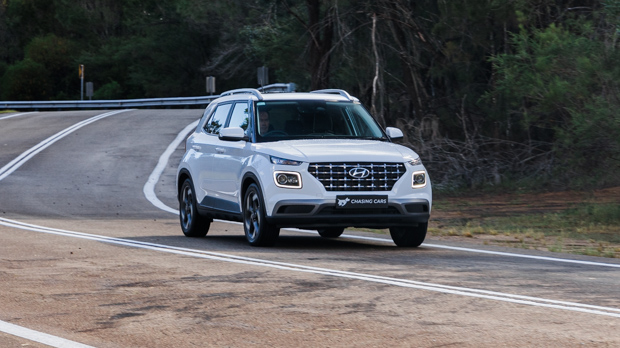
This isn’t helped by the fact the engine makes peak torque at 4850rpm, and peak power at a lofty 63000rpm – two aspects that would be remedied with the addition of a turbocharger.
This translates to a driving experience that can be often interrupted by the sound of the engine attempting to reach highway speeds as it revs well through the range.
Though Hyundai doesn’t quote a 0-100km/h time for the Venue, during independent testing, Chasing Cars found that it could achieve a best time of 9.74 seconds.
At almost ten seconds to 100km/h the Venue is on the slower side of the small SUV segment, but is on par with vehicles such as the Honda HR-V and the Toyota Yaris Cross.
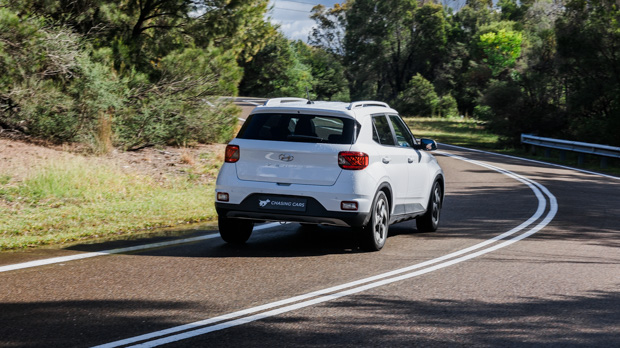
As the Venue sits on a torsion beam at the rear end, I didn’t have high hopes for it, and these expectations were met. This is not to say that the ride was harsh to the level of an i20 N, but it didn’t feel like there was much give.
At highway speeds, the ride is calm and composed, but the combination of rough surfaces and low-speed city commuting around Sydney was quick to show the limits of the Venue.
Considering the sheer size of the Venue, the fact that it handles more like a hatchback over an SUV is no real surprise.
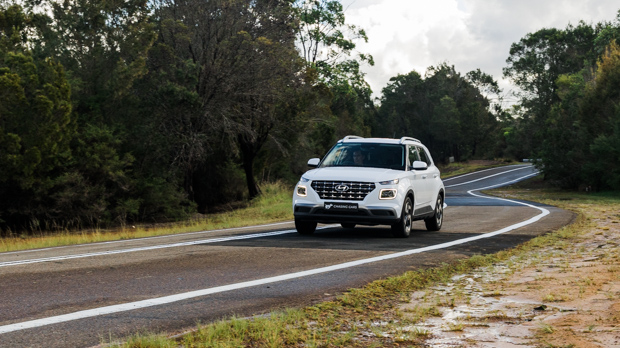
Despite the whiny nature of the engine, the dynamics of the Venue are fundamentally enjoyable, with a playful nature becoming obvious in the corners. The body control isn’t great, but I find that it only adds to this nature.
Drivers will quickly find the grip limits of the 205-wide tyres that the Venue sits on if they are pushing through corners.
Though this doesn’t instill a heap of confidence, it’s something that is very common in super-small SUVs at this price point.
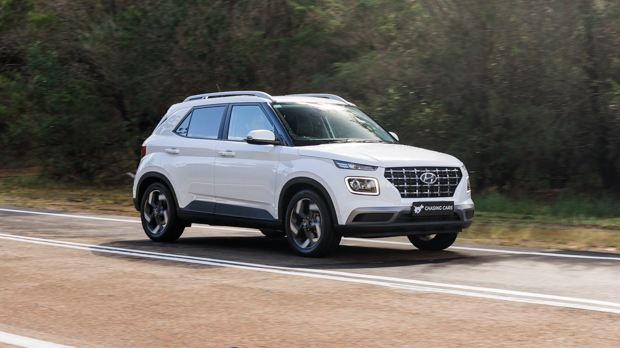
As a whole, the Venue packs an impressive level of refinement for its price bracket.
At times, the engine can be thrashy, and the fact that it doesn’t make peak torque until the top half of the tachometer doesn’t help its case, but I can’t imagine that most owners will be looking for performance in a Venue.
On the inside, the Venue offers a basic yet charming cabin. I say this because there’s a serious lack of premium-feeling materials, but the contrasting panels give it a somewhat retro look.
This basic theme is mostly down to the hard, textured plastic that can be found across the dash, on the door cards and covering the centre console.
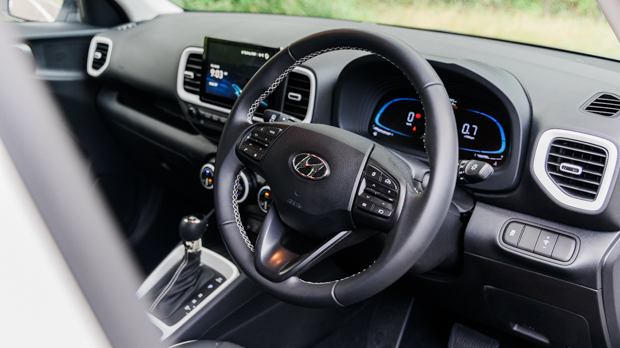
One aspect of the interior that I particularly like is the climate control system, which is made up of a trio of rotary dials.
Including the climate controls in the infotainment system is a very common occurrence in modern times, so tactile physical controls are a nice change.
In the centre of the dash sits an 8.0-inch infotainment screen, which is nice enough to use, but the lack of wireless phone connectivity might have buyers scratching their heads after forking out the cash for the range-topping variant.
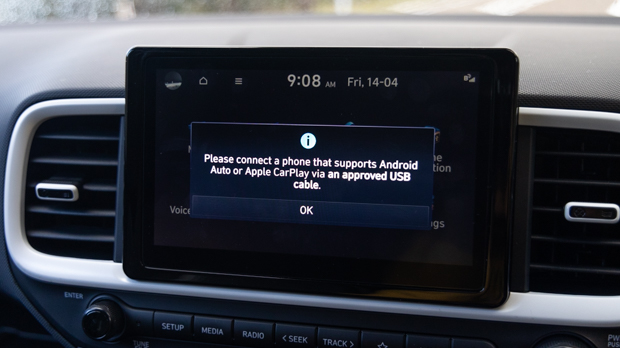
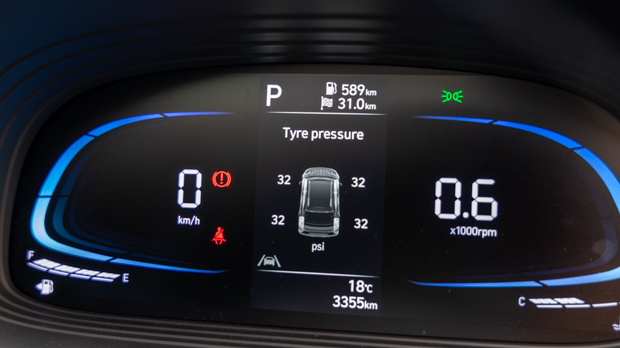
One redeeming factor here is the fact that Hyundai’s latest satellite navigation system is reasonably intuitive.
I’m not sure if this is something that annoys other people as much as it does myself, but the fact that phone mirroring is only available through the USB-A port rather than the USB-C really gets on my nerves.
The 4.2-inch digital cluster is also easy enough to use, but isn’t groundbreaking by any means.
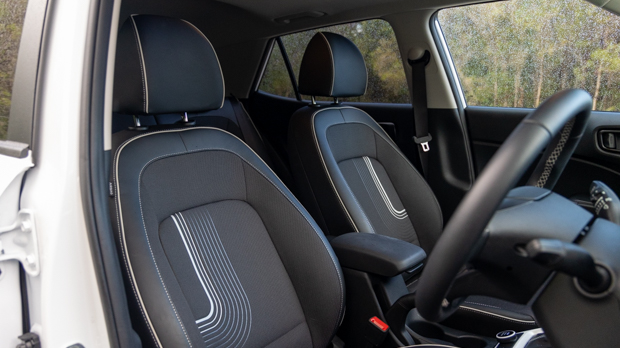
The same goes for the basic cloth seats across the front row. Though they are reasonably comfortable, the fact that neither have power adjustability in this top-spec Venue feels like a missed opportunity.
The second row of the Venue offers a surprising amount of space for the vehicle’s footprint, but in saying this, getting three passengers across the rear won’t be a comfortable experience for anyone involved.
This is likely down to the fact that the Venue’s roofline is reasonably high at 1592mm, but at 1770mm wide, it’s no wider than the regular hatchback.
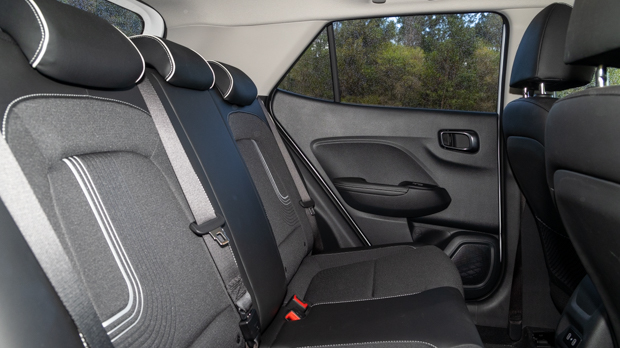
Despite being the range-topping Venue variant, this Elite still makes do with a manual tailgate at the rear.
Behind the rear seats, there’s 355 litres of cargo space on offer, even with the space-saver spare tyre tucked beneath the boot.
In terms of space, this is on-par with the likes of the Kia Stonic at 332 litres, and slightly down on the non-hybrid Toyota Yaris Cross at 390 litres.
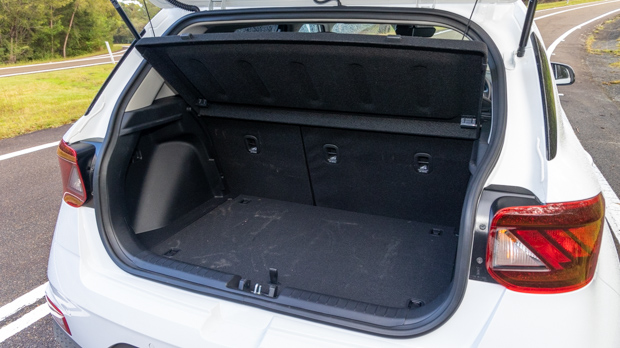
The topic of safety is where the proposition of the Venue starts to come undone, and this is mainly down to its age.
ANCAP tested the Venue back in 2019, where it received a four-star rating. Adult occupant protection was the only area where the SUV excelled, scoring 91 percent. It scored 81 percent in child occupant rating, and 62 percent in both vulnerable road user protection and safety assist.
This relatively low safety assist score comes as no real surprise, due to the fact that the Venue misses out on a few active systems such as adaptive cruise control, and any sort of speed monitoring assist.
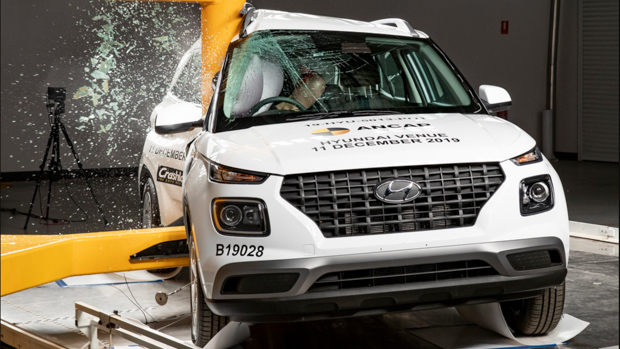
In saying this, it does get all-speed AEB, active lane-keeping assist, blind spot monitoring, and rear-cross traffic alert in this range-topping specification.
The standard cruise control system is perfectly fine to use, but feels a little low rent in the face of some of its rivals that come standard with an adaptive cruise control system.
The lane-keep assist system can also be a little finicky to use at times, with phantom road markings causing confusion.
With its relatively low entry cost, some might assume that the Venue will cost owners heavily in the long run, but I was pleasantly surprised to see that this is not the case.
Requiring just 91 octane fuel, the Venue Elite already gets a headstart on some of its 95-needing rivals, and on the road, we found that it would sip around 6.5-7.0L/100km.

This is not only down on Hyundai’s combined claim of 7.2L/100km, but is also reasonably frugal for a small SUV of its size that doesn’t get any hybrid assistance.
On the servicing front, Hyundai offers a five-year package to buyers that will cover the Venue up to 75,000km. This package costs $1575 upfront, with service intervals occuring every 12 months or 15,000km.
On the service front, the Venue is covered by Hyundai Australia’s five-year, unlimited-kilometre plan.
As a whole, the Hyundai Venue is an impressive offering at its price point among stiff competition in the small SUV segment.
The wheezy engine, basic interior, and lack of advanced safety features can let the Venue down at times, but these are all elements that won’t be deal-breakers for everyone.
A competitive price point, great driving dynamics, and cheap ownership costs are the bigger points that Hyundai has managed to nail with this small SUV.

I’d argue that these three are far more important to the majority of buyers in Australia, and make the Venue the well-rounded proposition that it is.
The elephant in the room is that Hyundai has released a facelifted version of the Venue in India, and while the brand’s local arm hasn’t revealed any plans to bring this car to the local market, it could be on the horizon.
For this reason, it might be worth holding off jumping into a Venue unless there’s an overly attractive offer on the table. You wouldn’t want to dump five-figures into an aging model right as the updated one is introduced.
Key specs (as tested)
About Chasing cars
Chasing Cars reviews are 100% independent.
Because we are powered by Budget Direct Insurance, we don’t receive advertising or sales revenue from car manufacturers.
We’re truly independent – giving you Australia’s best car reviews.
The estimate provided does not take into account your personal circumstances but is intended to give a general indication of the cost of insurance, in order to obtain a complete quote, please visit www.budgetdirect.com.au. Estimate includes 15%^ online discount.
^Conditions Apply
Budget Direct Insurance arranged by Auto & General Services Pty Ltd ACN 003 617 909(AGS) AFSL 241 411, for and on behalf of the insurer, Auto & General Insurance Company Limited(ABN 42 111 586 353, AFSL 285 571).Because we don’t know your financial needs, we can’t advise you if this insurance will suit you. You should consider your needs and the Product Disclosure Statement before making a decision to buy insurance. Terms and conditions apply.
Indicative quote based on assumptions including postcode , 40 year old male with no offences, licence suspensions or claims in the last 5 years, a NCD Rating 1 and no younger drivers listed. White car, driven up to 10,000kms a year, unfinanced, with no modifications, factory options and/or non-standard accessories, private use only and garaged at night.
^Online Discounts Terms & Conditions
1. Discounts apply to the premium paid for a new Budget Direct Gold Comprehensive Car Insurance, Third Party Property Only or Third Party Property, Fire & Theft Insurance policy initiated online on or after 29 March 2017. Discounts do not apply to optional Roadside Assistance.
2. Discounts do not apply to any renewal offer of insurance.
3. Discounts only apply to the insurance portion of the premium. Discounts are applied before government charges, taxes, levies and fees, including instalment processing fees (as applicable). The full extent of discounts may therefore be impacted.
4. We reserve the right to change the offer without notice.